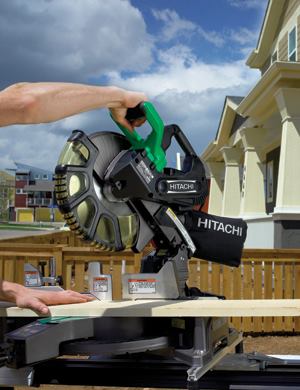The Winner
The best saw overall is the Hitachi. This solid machine has plenty of power and capacity, and some nice features that make it easy to set up quickly. I relied on the built-in laser and digitally displayed miter and bevel angles for speed and accuracy.
The second place saw is the brand-new Milwaukee. This company’s first 12-inch miter saw provides a fresh take on the category with some advanced features, such as the built-in worklights, the digital miter angle display, and the easiest bevel-locking operation.
Sharing third place are the Craftsman and DeWalt saws. The Craftsman was the second strongest of the test and has the most efficient dust collection, and the DeWalt is just an all-around good saw. Next comes the Ridgid with its extra-wide cutting capacity.
For my money, I prefer saws that offer the flexibility of dual bevel cutting, so the Makita and Bosch placed next, followed by the Ryobi. The Makita showed the greatest power of all the saws in the test, so if you only need a single bevel model, it is a strong machine for a good price.
Greg Londos is a veteran trim contractor in Hailey, Idaho.
Our No. 1, the Hitachi C12LDH has some nice features for quick and accurate setup of miter and bevel cuts. It’s the only saw in the test with a built-in laser and a digital display of miter and bevel angles. You can easily calibrate the switched laser, which also is well protected within the housing above the saw’s pivot point. This is the only laser in the test that doesn’t require the saw to be running to project a line, so you never have to move a board under a spinning blade with one hand. Other saws in our test with lasers have the centrifugally triggered, arbor-mounted variety, including Craftsman, Ridgid, and Ryobi. Hitachi’s digital display shows both miter and bevel angles in increments of 0.5 degrees, and it can be re-zeroed at any point so it is easier to add a degree or two to shave a joint tighter. The digital display module has a backlight for better visibility indoors, and you can switch off the unit when simply cross-cutting.
The Runner-Up
The second-place Milwaukee 6950-20 has unique, double worklights that illuminate the saw’s table on both sides of the blade. This helps you find your mark in dim areas and can even help reduce the shadows in daylight. The lights are well protected, mounted flush in the head of the saw, and operate by a switch on the trigger handle.
Milwaukee’s saw also has a backlit digital display that records the miter angle down to increments of 1/10 degree. It has a fine-adjustment knob to rotate the saw delicately without tapping it back and forth with your hand. This knob is the red ring mounted on the angle-lock lever. When engaged, it also serves as a detent override to make it easier to dial in an angle just a whisper off from a preset angle.
Fences and Extensions
Flip Fence: When the saw head is leaned over for bevel cuts, you have to move the fence out of the way. Some saws pivot the attached fence, flipping it upside down and outboard of the saw. On single bevel saws, such as the Makita LS1221, only the left fence flips, while on dual bevel saws, like the Hitachi, both fences must move out of the way. You only need to flip one at a time, however, depending on the bevel angle you’re cutting. One drawback is the lack of tall support near the blade. This can make it harder to cut vertical pieces or crown molding held at an angle on the saw’s table.
Sliding Fence: Sliding the top part of a saw’s fence over is another way to move it for bevel cutting. You unscrew a knob or release a cam lever on the back of the fence, slide it over in its track, and lock it back down. Single bevel saws, like the Ryobi TS1552LA and Bosch 3912, only slide the left fence.
Dual bevel saws, such as the Craftsman, DeWalt, and Ridgid, slide both left and right fences, and the Milwaukee slides its left fence but must remove the right, leaving tall workpieces unsupported.
Table Extensions: Extending the table of the miter saw provides more support for stabilizing long workpieces, but in the case of the Bosch, the extra 3-1/4 inches hardly seem worth it. Longer extensions of steel bars, like on the Ryobi, are also found on the Craftsman and Makita. Ryobi and Craftsman extensions also have adjustable stops for repeat cutting of relatively short lengths
Dust Collection, Clamp
The best dust collection was found on the Craftsman 315.21235, a saw that tied for third place with the DeWalt. The Craftsman’s simple scoop design close to the blade is the most efficient at directing most of the dust into the bag.
The Craftsman also has a quick-release work clamp that is fast and easy to use. The horizontal configuration works even when cutting steep bevel angles–unlike the vertical clamps–as it leaves plenty of room between it and the tilted saw head.
